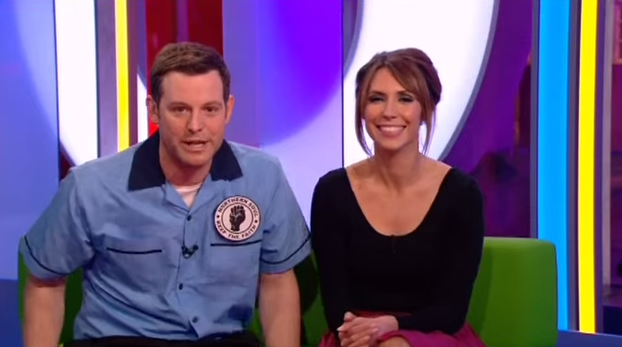Tuesday, 1 July 2014
Monday, 30 June 2014
Tuesday, 24 June 2014
Tuesday, 17 June 2014
Modes of Address
 Abiding by the rules and regulations of E4 was one of our main focuses. We had to think hardly about how our mode of address would be and how we will interact with our audience. As our target audience were teenagers we decided to go with the informal mode of address as younger people do nit speak like that,. This helped us a lot because when we did the dialogue script we ensured there was no modes of address to the audience that was Formal. Also this meant that we could not curse or anything like that due to the E4 community guidelines and the target audience being too young. Also our show would be placed before the watershed therefore making it impossible focus to curse in the show. If we broke any of these rules it would result in our show being to explicit to view and would result in not being allowed to view it.
Abiding by the rules and regulations of E4 was one of our main focuses. We had to think hardly about how our mode of address would be and how we will interact with our audience. As our target audience were teenagers we decided to go with the informal mode of address as younger people do nit speak like that,. This helped us a lot because when we did the dialogue script we ensured there was no modes of address to the audience that was Formal. Also this meant that we could not curse or anything like that due to the E4 community guidelines and the target audience being too young. Also our show would be placed before the watershed therefore making it impossible focus to curse in the show. If we broke any of these rules it would result in our show being to explicit to view and would result in not being allowed to view it.Mode Of Address:
We went with informal mode of address due to our target audience this is because nowadays people speak in slang but we ensured that we didnt but in a way teenagers will find it normal to listen to. Also we didnt go with formal because our target audience would find it abnormal to see a magazine show having a formal mode of address. Also as me and my partner Jada researched the Magazine Shows we figured it would be better to keep it a bit stereotypical and do informal because it is more fun to listen to and people can relate themselves to that.
Gestures:
As the Magazine show has to be energetic we ensured our hand gestures were correlating with it such as at the very start of the show when me and Jada are walking into the set we need to set an energetic standard for the audience so they are all pumped and ready to watch the show itself. This meant we needed strong hand gestures to match with our tone of voice. Something that we would possibl usew will be th waving hand gesture when we end of the show for the audience - (WAVING SAYING BYE) <-- These type of hand gestures will come in handy otherwise it will be plain and boring.
Sunday, 15 June 2014
Production Reflection Meeting 3 / Own Role Production 3
This week I managed to get my costume sorted for the Live Day Preparation. This meant I can upload images to my blog and annotate them so I can tell why I had chosen to wear the costume rather than wearing the other. This week I also took pictures with the costumes I have chosen to see how they actually looked in the lighting itself. It came to conclusion that I had to wear clothing that was light coloured. This was because they colours that were light made it more visible to see through the camera itself and there were no problems in seeing everything in the set. The colours of the lights we all agreed to was 2 oranges along with a purple filtered light which matched our background that the graphics designer created. I was working with my CO-Presenter Jada and the lighting Desk Ravinder to get some work done in preparation for the Live Day itself.
This week I also worked with the lighting department (ravinder) so I could get my costume pictures taken. We booked out 2 periods on Friday so we can get this done so I could get the costume ideas sorted out. By working with the Lighting Desk I managed to get my part of the work done and it saved time because the lighting manager knew how to set it up. This saved us a lot of time because if we did not know how to do it, it would have taken us twice as long to get help form a teacher so there was a major upside to the picture taking. We also used the colour scheme which we are using for the Live Day which Jasmeet and the Lighting Desk aggreed on so we get a better look at how the costumes look in the light that has been put up.
All the images were taken straight on so it showed any shadows which we can tell the director what to do, whether to add more lights or change the filters that we used. If I was to change anything I would actually add more costume ideas which I will be doing so I have a variety to work with.
This week I will head in the direction in completing this part of my blog and start to memorise the script so I can get an understanding of what I will be saying on the day of the live show. Also I will be working with Jada so we can work together to memorise the script and act out what we will be doing and saying. Also we will be rehearsing on Tuesday to get any new ideas and remove anything that dies not look good.
These images can be viewed here at :
http://thajeethanmulticamera.blogspot.com/2014/06/presenters-costumes-hair.html

This week I also worked with the lighting department (ravinder) so I could get my costume pictures taken. We booked out 2 periods on Friday so we can get this done so I could get the costume ideas sorted out. By working with the Lighting Desk I managed to get my part of the work done and it saved time because the lighting manager knew how to set it up. This saved us a lot of time because if we did not know how to do it, it would have taken us twice as long to get help form a teacher so there was a major upside to the picture taking. We also used the colour scheme which we are using for the Live Day which Jasmeet and the Lighting Desk aggreed on so we get a better look at how the costumes look in the light that has been put up.
All the images were taken straight on so it showed any shadows which we can tell the director what to do, whether to add more lights or change the filters that we used. If I was to change anything I would actually add more costume ideas which I will be doing so I have a variety to work with.
This week I will head in the direction in completing this part of my blog and start to memorise the script so I can get an understanding of what I will be saying on the day of the live show. Also I will be working with Jada so we can work together to memorise the script and act out what we will be doing and saying. Also we will be rehearsing on Tuesday to get any new ideas and remove anything that dies not look good.
These images can be viewed here at :
http://thajeethanmulticamera.blogspot.com/2014/06/presenters-costumes-hair.html

Thursday, 12 June 2014
Presenters - Costumes & Hair
Costumes, Hair & Make-Up:
For this part of my Preparation for the
Live Day which was thinking about the costume Ideas which I would implement.I
had to think about Hairstyles and costumes I could be wearing. As a boy the
make-up section would not work with me but would work for Jada as she is a girl
and she is the presenter. For the first part of the Preparation for the whole
Live Day/Show I had to create a mood board which would show what types of
clothes I could be wearing throughout the show itself. I aimed myself to do a
more causal clothing not something like a T-Shirt and Trousers but something in
the lines of a Polo Shirt, Trench Coat, Black/Blue Jeans & Trainers either
being High or Low Tops.
Also during this part of the preparation I
had to think about the Hair Style I could be doing to match my costume or in
general. This would have a clear visualization of what looks god and what
doesn't look good. Also when thinking about this I needed to think of the Mood
of the show, My characteristics I’ll be playing and the lighting of the set
itself. By having light clothing I can ensure that as A presenter I am visible
to the cameras and it does not destroy the aesthetic view of the show itself.
On the other hand if I was to wear dark clothing I think the cameras would find
it harder to capture my facial expressions and it will look grainy because the
lighting is quite dark. Also by the mood I mean if the person was lively I think
the hairstyle would be more cool and funky or if the person had a deep tone
voice they're hairstyle would be completely different. I think the hairstyle
would show how the characteristics of the person would be portrayed therefore
making it a major part of designing my costume that I would be wearing for the
Live Day itself.
As we are doing a Music Show and we are
having celebrities on the show I think I should wear something smart and more
appealing to teenagers; which brings me onto my next point I need to dress
appropriately to the target audience of the show which is teenagers. If I was
to wear a T-Shirt which had an in-appropriate image or word I think it would
break the watershed rule and would not appeal to the Target audience of the
Show itself. I think this is another major sector of the preparation I need to
be looking at during this section because I do not want to be breaking any
rules or anything that would set back the show itself. Also i can delay time
for having rehearsals because it will not be as appropriate. So therefore I
will not be heading towards the direction which will have words written on the
T-Shirt.
Also for this Friday which is the 13th I
will be going with the Lighting Desk (Arjan) to get some pictures of my
costumes that I could be wearing for the Live Day itself. These costumes will
decided which ones look good in the Lighting and what does not look good with
the lighting. I was aiming to wear clothes that are pretty light such as white
which is a Neutral colour. Also I will not be wearing a black top, Jacket due
to the fact that the Lights get very hot and it can be uncomfortable when
talking for 30 Minutes lives. For the lighting we went with 2 Orange Filters
with a blend of a Light with a purple filter which came out very well. Also
this matched our colour scheme for the logo that was created by the Graphics
Designer. As the lighting is Quite dark as mentioned above dark clothing will
not be worn which will make the cameras produce a grainy flicker when played
back. We aim to keep the presenters as if they were up to date with fashion and
they know what the latest trend in clothing is. Also as we have another presenter
we had a chat about wearing clothes that would match when we were next to each other.
For example if I wore jeans, t-shirt and Jacket she would wear something that
makes it match to an extent. Not colour wise but dress sense wise. Below you will find some costume ideas that I have come up with, these are taken with the lighting focused on me to see whether the costume looks good or not.
Also you can see that below the waist is all black. I have tried to keep it more clean and smart along with a suede type shoe which will work with any type of trousers or jeans. Also they will work with chinos but I think a different colour shoes would work something such as white. I think White puma suede will work with chinos. This will be seen with my 2nd costume Idea which I can be wearing. Also I have gone with a watch which is also black so it match whatever I am wearing for the live day itself. As I have tested costume Ideas with the lighting desk I think that light colours for the shirt would work very well and will not affect the way we are shown via the cameras.
Here I went out with the Lighting Desk to get some insight on how the costume would look with the colours I have chosen for the day and here are the images below of how they looked like in the light we had chosen and approved by the Director herself. These images will show a full preview of how the costume will be looking in the purple and orange light and how we can alter it if there were seeing issues on the set via the cameras.
Here we got a chair to sit me down just to re-create how it would look like when I am actually presenting the show because we will be sat down most of the time during the show.
I stood up for this picture because I wanted the light directly to hit on the costume to see how it looked like and the colour were almost perfect to see in the lighting setup we actually had which was very good and I was very happy with the outcome as I thought it was going to be more darker where I will need to change around the costume ideas.
Again I used a different top to see how it would look like if I were to be presenting with the same top for the day and this one also came out particularly well and I was very impressed with the outcomes of the costume which meant I could possibly wear anything light blue or white which would make it stand out on the day.
These Nike Shoes were suprising visible because it was a light grey type colour along with the suede.
These Nike trainers were fully black but still visible on the camera with the Lighting which was amazing because this meant any shoe could be visible in the Light without it being hard to see what colour it was.
These Puma shoes were easily visible aswell which meant I had a nice variety of shoes to wear. During this time period I went out and bought a pair of Nike Blazers which I will be wearing for the day and they were Light Grey so I knew it was going to be properly visible on the cameras.
Wednesday, 11 June 2014
Dialogue Script
I have been This week I will be working with my Partner Jada to create the script so we can have a clear understanding of what will be going on during the Show itself. The script will ensure what we will be saying and what the response we will be receiving from the audience itself. Also were told by our teacher to include Banter and Jokes and to make it a bit informal. Me and Jada will need to include all the details that we will be including in the script as it Faraha's Montage, Prabhjyot's Graphics ect. These will be indicated in bold so when we give it to the director it will be clear on what is happening during the show itself.
What i need to ensure while creating the script:
- Abide by the Running Order
- Include Banter / Jokes
- Be somewhat informal so it flows better (Relates to Teenagers)
- Make sure VT Operator parts / graphics / Montages are in Bold
- Also make the important parts in Bold and Centred to the Page
- Make sure I am using size 14 Font on Microsoft Office
- Also make sure that the script is Minimum 4 Pages (Could be longer depending on the detail of the script itself)
Here is the finished Dialogue Script :
What i need to ensure while creating the script:
- Abide by the Running Order
- Include Banter / Jokes
- Be somewhat informal so it flows better (Relates to Teenagers)
- Make sure VT Operator parts / graphics / Montages are in Bold
- Also make the important parts in Bold and Centred to the Page
- Make sure I am using size 14 Font on Microsoft Office
- Also make sure that the script is Minimum 4 Pages (Could be longer depending on the detail of the script itself)
Here is the finished Dialogue Script :
Sunday, 8 June 2014
Production Reflection Meeting 2 / Own Role Production 2
This week I had to carry on with the script with my partner Jada. We had to get a dialogue script done for the Live day itself in order to memorise / get a brief idea on what questions we would be asking. I was told that we needed to include where the graphics / overlays come into place during the course of the Live Show. In order to do that we had to abide by the running order which Me, Ellie & Jasmeet created. This week we completed the script itself which meant we got the heavy work off our shoulders and we could focus on acting our roles and memorising the questions we will be asking.
This week we managed to complete the dialogue script which meant we can proceed onto other duties we can work on. Also As I had worked with the director (jasmeet) it ensured I did not have anything that she was unhappy with. We spent a whole lesson on working on the script and around 3/4 of it was completed to an extent of detail. Jasmeet was happy with this so we gave it to Jada to finish off and add / remove things that were not really needed in the Script itself. After that was done me and Jada set off to start to learn and memorise our lines for the show itself so we had some extra preparation. Me and Jada as presenters communicated with each other over E-Mail & Instant Messaging so we could get the work done within the week and we did which was a major success regarding my own role.
The things we may need to change is the questions in the script because the questions looked a bit bland and they were not as funny as we could make them. This means I need to talk with Jasmeet and Jada to make the questions a bit more humorous and engaging to the audience.
This week I will be talking with Jasmeet and Jada what we will actually do during the Live Show itself. This means we need to talk about my personality, hand gestures ect. If I get this done it means I can proceed into building my character for the Live Day itself so I am prepared and not organised or behind on anything. This means I will be ready and prepared for the character I am cueing the Live Day itself. Also I will be starting to memorise the script as a preparation for the show as we have to master it in order to be near professional standards.
This week we managed to complete the dialogue script which meant we can proceed onto other duties we can work on. Also As I had worked with the director (jasmeet) it ensured I did not have anything that she was unhappy with. We spent a whole lesson on working on the script and around 3/4 of it was completed to an extent of detail. Jasmeet was happy with this so we gave it to Jada to finish off and add / remove things that were not really needed in the Script itself. After that was done me and Jada set off to start to learn and memorise our lines for the show itself so we had some extra preparation. Me and Jada as presenters communicated with each other over E-Mail & Instant Messaging so we could get the work done within the week and we did which was a major success regarding my own role.
The things we may need to change is the questions in the script because the questions looked a bit bland and they were not as funny as we could make them. This means I need to talk with Jasmeet and Jada to make the questions a bit more humorous and engaging to the audience.
This week I will be talking with Jasmeet and Jada what we will actually do during the Live Show itself. This means we need to talk about my personality, hand gestures ect. If I get this done it means I can proceed into building my character for the Live Day itself so I am prepared and not organised or behind on anything. This means I will be ready and prepared for the character I am cueing the Live Day itself. Also I will be starting to memorise the script as a preparation for the show as we have to master it in order to be near professional standards.
Saturday, 31 May 2014
Production Meeting Reflection 1 / Own Role Production 1
Within this week I had to ensure what I will be doing as the
role of the Presenter. I was a bit worried due to the fact that I did not get
any of my applied jobs which were my strong points as for being a graphics
designer I have had experience for over 3 Years and Cameraman I have been for 2
Years through the course of Media in GCSE. But as a presenter I will be able to
improve my skills in front of the camera.
Regarding this week I
was talking with Jasmeet and Ellie and helping out on the Running Order as well
as understanding what I would be doing throughout the course of the Live Show.
Us three sat down during the lesson and carefully went through what the
presenters would be doing and what the guests will be doing. After some
extensive group work we had a brief running order which I would then take home
and elaborate on for Jasmeet and Ellie to check and make changes to. As we have
made the running order it will be easier for me and Jada because we would know
what we would be doing on the day itself. This week has been very productive as we got the Running Order completed to an extent where we can start on the Master Script and get it done in time for the rehearsals of the show itself.
The group response to my idea and contribution was good
because everyone was happy with what was going on, on the running order. We all
got along and we all embedded our ideas to the Running Order to make it that
extra bit unique. We all had to agree on what we wanted on the running order
and it was important that we listened to Jasmeet as she was the Director. As
Jasmeet was the director we had to ensure everything was perfect through her
eyes. If there was any mistakes we would be informed by Jasmeet so we can get
that fixed in no time. After going home I made a more elaborated version of the
Running Order to Jasmeet.
The thing that has been successful this week is that the
running order was completed with the help of me as the presenter and Ellie.
This meant I and Jada can progress into making a simple script which me and her
will abide by so we don’t forget what we would be doing throughout the course
of the Live Show.
I need to develop what I would be doing as a presenter for
the live show and talk with my Partner Jada so we can settle to make a script.
Which brings me onto my next point: What I will be intending in doing next week
is that I need to create a script with Jada so I can ensure what I will be
doing on the Live TV Show itself.
Friday, 23 May 2014
Own Proposal Reflection
Before
we started the production meeting there had to be a camera that was set up in
order to record each and every one of us. This meant that everyone had to pitch
their ideas to the whole of class and receive feedback on their Production
Ideas. Each of us had a turn to say what our show was called and what our
actual unique selling point was for the production itself. By
doing this production meeting it ensured that we had heard all of the ideas
that were pitched and would have helped us figure out whose Idea we will be going
with for our Live Day. As we sat around the table it was awkward to start a discussion
and ask the questions to the person who had pitch their idea because most of
the questions were there same and there were no questions which were different
to the others.
This week I did my Media Pitch for my show which went very well. I made a show called Mix Direct which had a very strong correlation to a Music Type show. During this week I had to come up with a plan for my pitch, get the running order sorted, Set setup, Backgrounds ect. Regarding
my Pitch I had received some good and bad points which told me why my idea was
not as good as the others in the class. Some of the good points I received was
that my logo looked very professional with the Orange and Yellow colour scheme.
They also said the logo was vibrant and simple. Also the group liked the idea
of the wallpaper going on the green screen or the logo with some splatter
effect. Some of the negative comments I received was that my name was
unoriginal which “Mix Direct” was and it completely slipped my mind it was a DJ
Shop name. Also I did not have a unique selling point which also made my idea
rather boring.
We
voted for Jada’s Idea which was called “The Beat" which was correlated to Music
because there is the “beat” of the track. Also she had good unique selling
point. I personally voted for prabhjyots idea as he had a very good name of “Musology”
which instantly correlated to Music. Also he had games such as guess the
nose. He could have added a unique game
such as the hot seat which Kaval introduced on his pitch. Within the final idea
I think the hot seat Idea could have been incorporated as well as the twitter
Q&A. Jada's name particularly caught everyone's attention so therefore we went with that. We did alter some of the show itself by incorporating others' ideas which made it fair on everyone so it seemed like everyone had contributed as it was a team work Unit.
Wednesday, 14 May 2014
Live Pitch Recorded
Tuesday, 13 May 2014
MC Show pitch
For this task we have been asked to create a Music Program which will be around the 30 Minute Mark. The Program will need to contain around 2 Guests where questions will be asked in order to keep the program going without it being as boring. Below is the plan I have created for the program. I have tried to keep it unique as possible without copying others' ideas. This means that I could have the chance to air my program for the Media Live Day which is literally around the corner. Also below you will find my progress of building on the idea without it getting too boring.

 Before anything I needed to think of a name for my own program and the first thought that sprung into mind was Mix Direct. This is because the name itself correlates to music. "Mixing" songs are for DJ's but they use songs to mix. Also I added the word direct to the bottom in order to make it seem like we are the only show that actually puts up the latest in music. It "Directly" shows the music video to the viewers of the show. After creating the logo I looked at the logo and it did not have any colour and it looked boring and unappealing.So I went back to the drawing board and I made a logo which looked appealing and more professional. On your right you will see the new and improved logo of the Initial logo I had actually made. This has more colour and catches the audience's eye. Unlike the other one it has more colour and is more appealing. The fact that I have used a circle it adds an element of a Logo. Most logos have circular outer "shell". Now the logo has two shades of orange which looks very clean and it is not too glamorous looking.
Before anything I needed to think of a name for my own program and the first thought that sprung into mind was Mix Direct. This is because the name itself correlates to music. "Mixing" songs are for DJ's but they use songs to mix. Also I added the word direct to the bottom in order to make it seem like we are the only show that actually puts up the latest in music. It "Directly" shows the music video to the viewers of the show. After creating the logo I looked at the logo and it did not have any colour and it looked boring and unappealing.So I went back to the drawing board and I made a logo which looked appealing and more professional. On your right you will see the new and improved logo of the Initial logo I had actually made. This has more colour and catches the audience's eye. Unlike the other one it has more colour and is more appealing. The fact that I have used a circle it adds an element of a Logo. Most logos have circular outer "shell". Now the logo has two shades of orange which looks very clean and it is not too glamorous looking.
Again if I wanted to change the colour of the logo I would just have to change the Hue which will keep the same shades but change the colour to another colour with the same shades. Below you will see the same logo in a different colour. The fact that I have used two same colours in different shades I have the ability to change the colour by keeping the shades the same. This will be my final logo for the show itself.

The final logo is nice and bold which will clearly show the name of the show which is Mix Direct. It also looks like a classic logo from back in the dat. Like those neon lights shop logos. I have tried to create a logo which would look more professional as if it was to be on television. This will be the utmost final version of the logo as there is not much more to improve. This means now that I have my logo sorted out I can focus on all the graphics that can be used within the actual show it self. For example we can do an watermark overlay, Name graphics to show the Presenters' names ect. This will allow the program to have a flow and a large sign of professionalism.
What Is my called and what do I have planned for the show itself?
My show is called mix direct, I chose this name because it correlates to music and the word direct states that "You directly" get the news from the show. As a graphics designer I have professional standard overlays, logos, Intros, Outros ect planned for the show itself. This will add an element of professionalism to the show because we have near professional standard graphics available up for grabs. Before I actually get into the running order Below you will find some of the graphics that are available that will be included in the logo itself.
I have chosen a background with vibrant colours so its easily view able via the cameras. I decided to do this because the camera will not pick up dark colouring. This was figured when we were shown an example of previous Multi-Camera productions. Also with good lighting and this background the whole set will look more appealing and exciting. When watching the previus examples we found that without good lighting the set was too dark and boring to the viewers. I aim to make it to the nearest degree of making it professional; In order to do this I will need more than what we have in the school but for now I’ll need to adapt to what equipment I have actually got to use for the time being.
Things I will be Including during the course of my show:
Without a little quiz or game the show will not be very entertaining because constantly talking will bore people. Therefore I would have to include a game which will allow the Show to flow better aswelll as entertain the viewers without them losing there interst.
Game Ideas:
Here is a game which is fun and easy. Guessing the face. The aim of the game is to guess the face that is blurred to an extent where the person can figure out who it is. Each contestant has 3 Images to guess and rack up the points. At the end the person with the most correct answers out of 3 gets to win. The pictures are mainly of Mainstream artists which will make it that little bit easier for the people to view during the show itself.
Setup of the set:
Here I have gone with a simple yet effective setup where we can get single shots of the Presenters & Guests, Also we can get a full view of the set itself. This allows easy switches between the subjects. Also with this setup we can capture the facial expressions of all the people on the set.
The setup is also conventional and it covers everything for the viewers which is very helpful as if there was to be an unexpected moment we will be able to capture it without missing an aspect of the whole thing.
Running Order:
6:00-6:05 - Here we will be able to see the intro to the show itself where the two presenters introduce themselves and have a little clip of what the whole show is about. Also within this 5 Minutes we have a mini overview of what will be coming up on the show itself.
6:05-6:08- Here the presenters sit down and introduce their guests to their show anfd give a brief explanation of who they are. They will introduce both guests and make them feel comfortable and set the mood of the whole show.
6:08- 6:12 - After talking with the guests we interview briefly about the new music video they have made and show a clip of an aspect of the music video itself.
6:12-6:16 - We Interview the second guest and show a clip of their music video they have starred and sung in. Again only a portion of the music video will be shown throughout the course of the show.
6:16 -6:20 - We have a games round of guessing the picture. Each person gets 3 pictures to guess, person who has guessed the most will win the game itself.
6:20- 6:23 - We talk to the guests about both of their forthcoming albums and who will be featured in the songs. Also a new coming single will also be talked about during this period of time
6:23- 6:25 - Here we have a quiz that will take place and see if our guests are unto date with their Music. Quiz can involve song names, Albums Names, Celebrity Fights ect.
6:25-6:28 - After taking part in the quiz the presenters will reveal the prize for the winner of the show and give them a prize with a little celebration.
6:28-6:30 - They will end the show with answering a few questions from their twitter fans and tell the audience to follow them for a chance to win a big prize ect.

 Before anything I needed to think of a name for my own program and the first thought that sprung into mind was Mix Direct. This is because the name itself correlates to music. "Mixing" songs are for DJ's but they use songs to mix. Also I added the word direct to the bottom in order to make it seem like we are the only show that actually puts up the latest in music. It "Directly" shows the music video to the viewers of the show. After creating the logo I looked at the logo and it did not have any colour and it looked boring and unappealing.So I went back to the drawing board and I made a logo which looked appealing and more professional. On your right you will see the new and improved logo of the Initial logo I had actually made. This has more colour and catches the audience's eye. Unlike the other one it has more colour and is more appealing. The fact that I have used a circle it adds an element of a Logo. Most logos have circular outer "shell". Now the logo has two shades of orange which looks very clean and it is not too glamorous looking.
Before anything I needed to think of a name for my own program and the first thought that sprung into mind was Mix Direct. This is because the name itself correlates to music. "Mixing" songs are for DJ's but they use songs to mix. Also I added the word direct to the bottom in order to make it seem like we are the only show that actually puts up the latest in music. It "Directly" shows the music video to the viewers of the show. After creating the logo I looked at the logo and it did not have any colour and it looked boring and unappealing.So I went back to the drawing board and I made a logo which looked appealing and more professional. On your right you will see the new and improved logo of the Initial logo I had actually made. This has more colour and catches the audience's eye. Unlike the other one it has more colour and is more appealing. The fact that I have used a circle it adds an element of a Logo. Most logos have circular outer "shell". Now the logo has two shades of orange which looks very clean and it is not too glamorous looking.Again if I wanted to change the colour of the logo I would just have to change the Hue which will keep the same shades but change the colour to another colour with the same shades. Below you will see the same logo in a different colour. The fact that I have used two same colours in different shades I have the ability to change the colour by keeping the shades the same. This will be my final logo for the show itself.

The final logo is nice and bold which will clearly show the name of the show which is Mix Direct. It also looks like a classic logo from back in the dat. Like those neon lights shop logos. I have tried to create a logo which would look more professional as if it was to be on television. This will be the utmost final version of the logo as there is not much more to improve. This means now that I have my logo sorted out I can focus on all the graphics that can be used within the actual show it self. For example we can do an watermark overlay, Name graphics to show the Presenters' names ect. This will allow the program to have a flow and a large sign of professionalism.
What Is my called and what do I have planned for the show itself?
My show is called mix direct, I chose this name because it correlates to music and the word direct states that "You directly" get the news from the show. As a graphics designer I have professional standard overlays, logos, Intros, Outros ect planned for the show itself. This will add an element of professionalism to the show because we have near professional standard graphics available up for grabs. Before I actually get into the running order Below you will find some of the graphics that are available that will be included in the logo itself.
 |
| VISUAL STYLE Background for the Show itself. Will be placed on a board behind the Presenters & Guests |
I have chosen a background with vibrant colours so its easily view able via the cameras. I decided to do this because the camera will not pick up dark colouring. This was figured when we were shown an example of previous Multi-Camera productions. Also with good lighting and this background the whole set will look more appealing and exciting. When watching the previus examples we found that without good lighting the set was too dark and boring to the viewers. I aim to make it to the nearest degree of making it professional; In order to do this I will need more than what we have in the school but for now I’ll need to adapt to what equipment I have actually got to use for the time being.
Things I will be Including during the course of my show:
Without a little quiz or game the show will not be very entertaining because constantly talking will bore people. Therefore I would have to include a game which will allow the Show to flow better aswelll as entertain the viewers without them losing there interst.
Game Ideas:
Here is a game which is fun and easy. Guessing the face. The aim of the game is to guess the face that is blurred to an extent where the person can figure out who it is. Each contestant has 3 Images to guess and rack up the points. At the end the person with the most correct answers out of 3 gets to win. The pictures are mainly of Mainstream artists which will make it that little bit easier for the people to view during the show itself.
Setup of the set:
Here I have gone with a simple yet effective setup where we can get single shots of the Presenters & Guests, Also we can get a full view of the set itself. This allows easy switches between the subjects. Also with this setup we can capture the facial expressions of all the people on the set.
The setup is also conventional and it covers everything for the viewers which is very helpful as if there was to be an unexpected moment we will be able to capture it without missing an aspect of the whole thing.
Running Order:
6:00-6:05 - Here we will be able to see the intro to the show itself where the two presenters introduce themselves and have a little clip of what the whole show is about. Also within this 5 Minutes we have a mini overview of what will be coming up on the show itself.
6:05-6:08- Here the presenters sit down and introduce their guests to their show anfd give a brief explanation of who they are. They will introduce both guests and make them feel comfortable and set the mood of the whole show.
6:08- 6:12 - After talking with the guests we interview briefly about the new music video they have made and show a clip of an aspect of the music video itself.
6:12-6:16 - We Interview the second guest and show a clip of their music video they have starred and sung in. Again only a portion of the music video will be shown throughout the course of the show.
6:16 -6:20 - We have a games round of guessing the picture. Each person gets 3 pictures to guess, person who has guessed the most will win the game itself.
6:20- 6:23 - We talk to the guests about both of their forthcoming albums and who will be featured in the songs. Also a new coming single will also be talked about during this period of time
6:23- 6:25 - Here we have a quiz that will take place and see if our guests are unto date with their Music. Quiz can involve song names, Albums Names, Celebrity Fights ect.
6:25-6:28 - After taking part in the quiz the presenters will reveal the prize for the winner of the show and give them a prize with a little celebration.
6:28-6:30 - They will end the show with answering a few questions from their twitter fans and tell the audience to follow them for a chance to win a big prize ect.
Friday, 2 May 2014
Monday, 28 April 2014
Multi-Camera Job Rules
Multi Camera Job Roles:
There are 10 main Job roles in TV Production, these are very important job which allow the audience to enjoy what we watch on Television itself. Without these main jobs you would not be expecting the best program which would entertain you as they have not included one of the jobs. Each job role interlinks with one another which is the Hierarchy of the TV Production. There are jobs which are on top of others due to their importance for example the Lighting desk would be linked with the Cameraman and director as the Cameraman would want the lighting to be dimmer or more focused on an object and the director would want it to be in a place where he wants it as the director is making it more visually appealing for the audience who are viewing at home.
Without each and every one of these job roles a program will not be what it is because for example if you are missing a Lighting Desk the camera will not pick up the faces that the lighting was supposed to be pointed at therefore will make the program very unappealing to the viewers at home. As mentioned before these job roles all link in with each other because in each and every job communication is vital or one tiny mistake can affect the outcome of the program itself.
The 10 Job Roles are:
- Camera Operator
- Sound mixing
- Vision mixing
- Directing
- Set Designer
- Lighting Desk
- Floor Manager
- Graphics Generation
- VT Operator
- Presenter
Camera Operator:
 The camera operator operates one of the few cameras which are in near fixed position. There will be other Camera operators as it is a Multi-Camera shoot. The camera operator usually gets his directions via the headset they are wearing to get the shots the director wants to be shown. The Camera Man should have the ability to multi-task meaning he should always concentrate on the main jobs he has been given otherwise the outcome of the shot/framing would not look appealing. The cameraman mostly works with the Director, Lighting Desk, Actor, Sound Operators. Without any of the actor, sound operators, lighting desks being perfect the Cameraman will not be able to proceed in recording the scene. The cameraman is the senior jobs out of the Camera departments as it is the most important job role in the category. The camera man has to carefully listen to the information the Director says from the "Gallery" where he stays away from the set. If these instructions are not heard the flow of the program may change due to the direction not being heard. This makes things harder for everyone as there is a break in the communication between all the roles that are being done. If the cameraman for instance did not hear the instructions the actors will not be able to carry onto the next shot without perfecting the previous. As well as having communication skills there are specific roles the Camera Man needs to have in order to qualify as being a cameraman, otherwise the job maybe not suitable for people; These are:
The camera operator operates one of the few cameras which are in near fixed position. There will be other Camera operators as it is a Multi-Camera shoot. The camera operator usually gets his directions via the headset they are wearing to get the shots the director wants to be shown. The Camera Man should have the ability to multi-task meaning he should always concentrate on the main jobs he has been given otherwise the outcome of the shot/framing would not look appealing. The cameraman mostly works with the Director, Lighting Desk, Actor, Sound Operators. Without any of the actor, sound operators, lighting desks being perfect the Cameraman will not be able to proceed in recording the scene. The cameraman is the senior jobs out of the Camera departments as it is the most important job role in the category. The camera man has to carefully listen to the information the Director says from the "Gallery" where he stays away from the set. If these instructions are not heard the flow of the program may change due to the direction not being heard. This makes things harder for everyone as there is a break in the communication between all the roles that are being done. If the cameraman for instance did not hear the instructions the actors will not be able to carry onto the next shot without perfecting the previous. As well as having communication skills there are specific roles the Camera Man needs to have in order to qualify as being a cameraman, otherwise the job maybe not suitable for people; These are:
- Having excellent Colour Vision; This meaning if you are a person who does not have great colour vision the camera man role will not be suitable as he needs to see how the framing looks, how the colour looks on the screen with the lighting. If he is not happy with the way the colours are presented the lighting may have to be adjusted.
- The cameraman has to have a good affinity with the Technology he is using: The cameraman has to have a natural understanding of technology. For instance he needs to know all the basic and complex functions of the Studio Camera he is using and overcome problems that may occur. If this cannot be lived upto the person will not be able to get the job as a cameraman.
- Cameraman will be able to carry out instructions to a great degree of accuracy: The cameraman should be able to replicate the instructions he has been given by the director. The cameraman has to be able to execute these instructions without making any margin of error: This meaning he needs to have steady hands, good hearing, a high margin of concentration so he can hear what the director has told him and also have good recall with the director.
- He camera man needs to have very good attention to detail: Along with Focus, Attention, Concentration & Recall the cameraman will need to get everything perfect. What the Director sees through his mind, the cameraman has to bring to reality. Having attention to detail means he needs to have the framing to the best degree possible or it may turn out more badly than expected and the director may ask to re-film the shot. The cameraman is the person who has to make the framing look good (Aesthetic) in order for the viewer to enjoy the show they are filming for.
- The cameraman has to have the skill of composing the shot and having speed and precision: Along with the basic skills needed to be a camera man, the cameramen has to have precision and speed. Once instructed by the Director they literally have a short amount of time to execute the shot he/she has been told to do.
- As stated by creativeskillset.org to be a cameraman you need to have some physical stamina and strength which most jobs do not need: It states that you need to be able to lift heavy equipment in particularly the cameras as they are big and heavy and run of the mains. Also they need to have the stamina for working for very long hours. This means staying in the studio all day doing extensive camera work and moving around sets. As well as this mentioned above you need to concentrate all the time in order to get all the dedicated work done for the set/program.
While the "Cameraman Job" seems simple, it is one of the difficult ones. People assume it is just like using a expensive camera which is then put on a tripod but these cameras are worth more than £5000 and they need to be handled with care and they have hundreds more functions than an ordinary camera. You need to have many skills alone to become a cameraman for example, Long Hours + Concentration, Speed & Precision + Attention to detail. All these skills come into play while behind the camera which means it is compulsory to have these skills to be a cameraman.
Lighting Desk:
 The lighting Desk itself has full responsibilities of the lighting that is done within the set. They must have great vision on how the set will look like with the lighting on the desk. The lighting desk usually sets up where the lights should point at towards a person and how it should look to the cameraman. This is where the hierarchy comes in as the Lighting Desk must co-operate with the Cameraman and the director. Without this type of strong communication they will not be able to have good quality lighting which may make the shot too dark. Without the lighting desk we will not have a perfect view and colour balance of the presenter or even the whole set.
The lighting Desk itself has full responsibilities of the lighting that is done within the set. They must have great vision on how the set will look like with the lighting on the desk. The lighting desk usually sets up where the lights should point at towards a person and how it should look to the cameraman. This is where the hierarchy comes in as the Lighting Desk must co-operate with the Cameraman and the director. Without this type of strong communication they will not be able to have good quality lighting which may make the shot too dark. Without the lighting desk we will not have a perfect view and colour balance of the presenter or even the whole set.
- Perfect Colour vision is vital for the Lighting Desk: In order to qualify for a Lighting Desk Job you will need to have excellent colour vision which will allow you to see a perfect image of the set and adjust the intensity of the light which is pointed at the presenter or the object on the set. Also if commanded by the director to add different coloured lights he/she will need to know the perfect balance for the set itself.
- Great knowledge of the equipment: The lighting desk operator has many buttons that will do different things but if there is no knowledge on what the buttons do there will be a problem if he/she doesn’t know what to do or how to do it. Without extensive knowledge about the equipment it can become a total mess which will lead to major problems.
- Good Attention to detail: This means that the set must be looking perfect with how the set looks with the lighting. Any anomalies in how the set looks like: as in there are shadows which are visible on the camera which will need to be removed with another light on the set. With these little attentions to detail they are able to perfect the outcome without any interruptions.
- They need to be able to manage the equipment purchased (budget) and advice what equipment should be purchased: This means they should know what the price of the equipment is and see what the best is for the price it is priced at. They also should know what they will be spending they're money on.
- Assembling the equipment: This means the lights have to been put up by themselves because others on the set are not qualified to set up the lights for the set which means the Lighting Desk Operator will only know how to do it.
- Attend earlier to the set: This means the Lighting Operator needs to be on the set early than the others to set up the equipment so there is no time wasted within the set for setting up the Lighting itself.
Director:

This is the most important job in the Multi-Camera business. The director has the highest stress between all the others' that are working in the set or outside the set. Without the director you will not be able to be on track when recording as it will get out hand. The director "directs" everyone on what to do. This means everything the director says is taken into account and done. With the director everything on set is perfect and there will be no problems with anyone.
- Have a very good understanding of what the viewers want: The director has to spend so much time in planning out what the Program will look like. This means they need to spend hours on end to perfect on what they want to view to the viewers. Also he/she must know to an extent what they will be saying to the other Operators to see what he has visualised in his mind.
- He/she must know about Marketing: The director not only has to tell everyone what to do, he/she should know all the expenses in Multi Camera Production. The director when planning has to go through the process of thinking out all of the expenses of producing such a program. This is where the director needs to manage his/her budget depending on how he/she wants to portray what he sees in his mind to the viewers.
- Good communication skills: The director also needs to have the best communication skill on the set because he needs to have a crystal clear communication skill in order for everyone to understand what he wants done on the set without getting into trouble or wasting time.
- Punctuality: The director literally has to be first on the set. Where they need to plan what he/she wants to see via the camera. Without the director on time/earlier than everyone nothing can take place or even proceed into recording stages. If that were to happen it will turn out horrible and not what the director has visualised.
Sound Mixer:

The Sound Mixer also has a very important job because he/she has to perfect the sound quality while recording. Without the sound you will not be able to hear anything that is being said through the mic.
- The Operator of the Sound has to perfect their understanding of the Sound table: The sound mixer should know what is going on the Sound Table. This means if the director asked to fade the voice of the presenter he/she should be able to do that without a doubt.
- Good instruction Recall / Memory: Without this skill the Sound Mixer may do something completely wrong which will result in recording the shit again which would waste a whole lot of time. Also by memory he should also know what each and every button does.
- Knowledge of the script itself: The Sound Mixer should know what the director wants to hear via the script itself. He/she has to do exactly what he/she sees on the script. This means the sound Mixer must visualise and portray through the sound board.
Graphics Designer :
 The graphics designer of the set shows all the images that will be broadcasted on the program. Without images and creative ideas the program will look very un appealing and boring.
The graphics designer of the set shows all the images that will be broadcasted on the program. Without images and creative ideas the program will look very un appealing and boring.
- Creativity: This is the key skill the Graphics Designer must have. Without the creativity the program's graphics will look very boring. Along with creativity they must be able to portray a very professional looking image which will help the program be more appealing. Without a sense of creativity you won’t be able attract viewers to watch the program.
- Editing Skills: hey must have a very good understanding of the program that they are using to edit, In this case Photoshop. They must know how t make a image what the director wants. They need to create the image of what the director is thinking.
- Ability to work with everyone: This meaning they need to have good communication skills with others and do what they need for their part of their job. The graphics designer also plays a big portion of the program as without effects and images the show will be very unappealing.
Vision Mixer:
 This job allows showing what the viewers see at home. He can cut and remove parts of the program or even change the camera position so it flows better. He can cut between shots and make it more aesthetic related so the viewers at home are engaged.
This job allows showing what the viewers see at home. He can cut and remove parts of the program or even change the camera position so it flows better. He can cut between shots and make it more aesthetic related so the viewers at home are engaged.
- Editing Skills: This is a major player of the Vision Mixer job. He/she must be able to edit without putting themselves into problems. Also they should know all the buttons that do what they do. For example changing the Colour Correction, Contract, Brightness ect. Without a clear understanding of the job they will not be able to do the job properly.
- Able to have attention to detail: The vison mixer must be able to an extent where you will be able to see all the important parts of the program without missing a single segment which may disrupt the flow of the program.
- Multitasking: The Vision Mixer must be able to Multi-Task this meaning doing two or more things at once. Hearing the sound and matching it with the footage that they have captured or adding music into the timeline which has to flow well. Adding this graphics into the footage to show to the viewers.
Set Designer :
 The set designer usually designs the outcome of the set, This meaning how the set will look like through the camera and how the viewers at home will be able to see it.
The set designer usually designs the outcome of the set, This meaning how the set will look like through the camera and how the viewers at home will be able to see it.
- Designer Skills/Creativity: The set designer must have very good creativity with how the set will look like and the colours of the set whether they are vibrant to portray a felling or dull to portray another feeling. The designer must also have a clear understanding of where the props will go and where all the objects will be placed.
- Set Creativity: This meaning they ned to have a unique placement of all the object which will not imitate other programs similar to the genre. This means the placement of the objects will determine where the Cameras will be set. Without a set designer ity will look visually unappealing to the audience and potentially lose viewers which may result in a disaster.
- Communication with the Director: The set designer needs to follow the directors commands on what he/she want the set to look like. Then after listening the director the set designer needs to imitate what he/.she has heard into real life.
Presenter :

The presenter is the main face of the whole show. Without the presenter the show cannot take place as there is no one to talk to the cameras for the viewers to see at home and enjoy.
- Have good confidence and ability to express: By this I mean they cannot be camera shy and they need to have a voice which will attract viewers to watch. They need to have very high levels of confidence through their face and voice which will show they are professional. Without this main skill they will be stuttering and it will look very boring for the viewers at home.
- Presenter should know what they are going to say: They need to revise the script for the show but add an element of themselves: as in they should not be talking like a robot that just has read the script and repeat, they have to add an element of reality to make it look more professional.
- Very good memory: The presenter among all the others should have the best memory because revising a script is a very hard job. They need to know what the script exactly wants them to say and when they want it want to be said. Without good memory the presenter will forget what is coming up next on the show or even forget what needs to be said on the show.
VT Operator:

This job is here so that the Tv Program goes on air for the viewers on TV. this means that the viewers at home are able to view it on the particular channel it has bee plsced on.
- Knowing the equipment very well : This is vital for a VT Operator because if he doesnt know what the buttons or function do he maybe in trouble for boradcasting the program on air. Also he may accidentally air the wrong parts of the program or even a whole different program. This means he needs to be on fully alert at all times and know what he is doing or else things can go wrong and the program may not go on air.
- Communication with thte Director: This is again vi9tal because if there is no communication with the director he can air the wrong things. So this means the VT Operator needs to always have communication so he know what he is doing.
- Deadlines: The VT Operator must be meeting strict deadlines for the airing of the program because if it is not met then everything will go wrong and you may lose audiences who may watch the program and if it not on time it will cost them more time.
 Floor Manager:
Floor Manager:
The floor manager manages what ever goes on the floor. Hand gestures are given in order for the Cameramen to know and the presenters. These instructions are strict and cannot been discarded.
- Communication: The communication skill here is very important because without the hand gestures and communication no one will kniow what they need to do, so this means they will be left there without any help and everything can go wrong.
- Organisation Skills / Planning : The floor manager has to have everything palnned of what they are going to say during the course of filming. With organisation skills present she/he will be able to do what they are supposed to do and tell the cameraman what to do. http://www.prospects.ac.uk/television_camera_operator_job_description.htm
There are 10 main Job roles in TV Production, these are very important job which allow the audience to enjoy what we watch on Television itself. Without these main jobs you would not be expecting the best program which would entertain you as they have not included one of the jobs. Each job role interlinks with one another which is the Hierarchy of the TV Production. There are jobs which are on top of others due to their importance for example the Lighting desk would be linked with the Cameraman and director as the Cameraman would want the lighting to be dimmer or more focused on an object and the director would want it to be in a place where he wants it as the director is making it more visually appealing for the audience who are viewing at home.
Without each and every one of these job roles a program will not be what it is because for example if you are missing a Lighting Desk the camera will not pick up the faces that the lighting was supposed to be pointed at therefore will make the program very unappealing to the viewers at home. As mentioned before these job roles all link in with each other because in each and every job communication is vital or one tiny mistake can affect the outcome of the program itself.
The 10 Job Roles are:
- Camera Operator
- Sound mixing
- Vision mixing
- Directing
- Set Designer
- Lighting Desk
- Floor Manager
- Graphics Generation
- VT Operator
- Presenter
Camera Operator:
 The camera operator operates one of the few cameras which are in near fixed position. There will be other Camera operators as it is a Multi-Camera shoot. The camera operator usually gets his directions via the headset they are wearing to get the shots the director wants to be shown. The Camera Man should have the ability to multi-task meaning he should always concentrate on the main jobs he has been given otherwise the outcome of the shot/framing would not look appealing. The cameraman mostly works with the Director, Lighting Desk, Actor, Sound Operators. Without any of the actor, sound operators, lighting desks being perfect the Cameraman will not be able to proceed in recording the scene. The cameraman is the senior jobs out of the Camera departments as it is the most important job role in the category. The camera man has to carefully listen to the information the Director says from the "Gallery" where he stays away from the set. If these instructions are not heard the flow of the program may change due to the direction not being heard. This makes things harder for everyone as there is a break in the communication between all the roles that are being done. If the cameraman for instance did not hear the instructions the actors will not be able to carry onto the next shot without perfecting the previous. As well as having communication skills there are specific roles the Camera Man needs to have in order to qualify as being a cameraman, otherwise the job maybe not suitable for people; These are:
The camera operator operates one of the few cameras which are in near fixed position. There will be other Camera operators as it is a Multi-Camera shoot. The camera operator usually gets his directions via the headset they are wearing to get the shots the director wants to be shown. The Camera Man should have the ability to multi-task meaning he should always concentrate on the main jobs he has been given otherwise the outcome of the shot/framing would not look appealing. The cameraman mostly works with the Director, Lighting Desk, Actor, Sound Operators. Without any of the actor, sound operators, lighting desks being perfect the Cameraman will not be able to proceed in recording the scene. The cameraman is the senior jobs out of the Camera departments as it is the most important job role in the category. The camera man has to carefully listen to the information the Director says from the "Gallery" where he stays away from the set. If these instructions are not heard the flow of the program may change due to the direction not being heard. This makes things harder for everyone as there is a break in the communication between all the roles that are being done. If the cameraman for instance did not hear the instructions the actors will not be able to carry onto the next shot without perfecting the previous. As well as having communication skills there are specific roles the Camera Man needs to have in order to qualify as being a cameraman, otherwise the job maybe not suitable for people; These are:- Having excellent Colour Vision; This meaning if you are a person who does not have great colour vision the camera man role will not be suitable as he needs to see how the framing looks, how the colour looks on the screen with the lighting. If he is not happy with the way the colours are presented the lighting may have to be adjusted.
- The cameraman has to have a good affinity with the Technology he is using: The cameraman has to have a natural understanding of technology. For instance he needs to know all the basic and complex functions of the Studio Camera he is using and overcome problems that may occur. If this cannot be lived upto the person will not be able to get the job as a cameraman.
- Cameraman will be able to carry out instructions to a great degree of accuracy: The cameraman should be able to replicate the instructions he has been given by the director. The cameraman has to be able to execute these instructions without making any margin of error: This meaning he needs to have steady hands, good hearing, a high margin of concentration so he can hear what the director has told him and also have good recall with the director.
- He camera man needs to have very good attention to detail: Along with Focus, Attention, Concentration & Recall the cameraman will need to get everything perfect. What the Director sees through his mind, the cameraman has to bring to reality. Having attention to detail means he needs to have the framing to the best degree possible or it may turn out more badly than expected and the director may ask to re-film the shot. The cameraman is the person who has to make the framing look good (Aesthetic) in order for the viewer to enjoy the show they are filming for.
- The cameraman has to have the skill of composing the shot and having speed and precision: Along with the basic skills needed to be a camera man, the cameramen has to have precision and speed. Once instructed by the Director they literally have a short amount of time to execute the shot he/she has been told to do.
- As stated by creativeskillset.org to be a cameraman you need to have some physical stamina and strength which most jobs do not need: It states that you need to be able to lift heavy equipment in particularly the cameras as they are big and heavy and run of the mains. Also they need to have the stamina for working for very long hours. This means staying in the studio all day doing extensive camera work and moving around sets. As well as this mentioned above you need to concentrate all the time in order to get all the dedicated work done for the set/program.
While the "Cameraman Job" seems simple, it is one of the difficult ones. People assume it is just like using a expensive camera which is then put on a tripod but these cameras are worth more than £5000 and they need to be handled with care and they have hundreds more functions than an ordinary camera. You need to have many skills alone to become a cameraman for example, Long Hours + Concentration, Speed & Precision + Attention to detail. All these skills come into play while behind the camera which means it is compulsory to have these skills to be a cameraman.
Lighting Desk:
 The lighting Desk itself has full responsibilities of the lighting that is done within the set. They must have great vision on how the set will look like with the lighting on the desk. The lighting desk usually sets up where the lights should point at towards a person and how it should look to the cameraman. This is where the hierarchy comes in as the Lighting Desk must co-operate with the Cameraman and the director. Without this type of strong communication they will not be able to have good quality lighting which may make the shot too dark. Without the lighting desk we will not have a perfect view and colour balance of the presenter or even the whole set.
The lighting Desk itself has full responsibilities of the lighting that is done within the set. They must have great vision on how the set will look like with the lighting on the desk. The lighting desk usually sets up where the lights should point at towards a person and how it should look to the cameraman. This is where the hierarchy comes in as the Lighting Desk must co-operate with the Cameraman and the director. Without this type of strong communication they will not be able to have good quality lighting which may make the shot too dark. Without the lighting desk we will not have a perfect view and colour balance of the presenter or even the whole set.- Perfect Colour vision is vital for the Lighting Desk: In order to qualify for a Lighting Desk Job you will need to have excellent colour vision which will allow you to see a perfect image of the set and adjust the intensity of the light which is pointed at the presenter or the object on the set. Also if commanded by the director to add different coloured lights he/she will need to know the perfect balance for the set itself.
- Great knowledge of the equipment: The lighting desk operator has many buttons that will do different things but if there is no knowledge on what the buttons do there will be a problem if he/she doesn’t know what to do or how to do it. Without extensive knowledge about the equipment it can become a total mess which will lead to major problems.
- Good Attention to detail: This means that the set must be looking perfect with how the set looks with the lighting. Any anomalies in how the set looks like: as in there are shadows which are visible on the camera which will need to be removed with another light on the set. With these little attentions to detail they are able to perfect the outcome without any interruptions.
- They need to be able to manage the equipment purchased (budget) and advice what equipment should be purchased: This means they should know what the price of the equipment is and see what the best is for the price it is priced at. They also should know what they will be spending they're money on.
- Assembling the equipment: This means the lights have to been put up by themselves because others on the set are not qualified to set up the lights for the set which means the Lighting Desk Operator will only know how to do it.
- Attend earlier to the set: This means the Lighting Operator needs to be on the set early than the others to set up the equipment so there is no time wasted within the set for setting up the Lighting itself.
Director:

This is the most important job in the Multi-Camera business. The director has the highest stress between all the others' that are working in the set or outside the set. Without the director you will not be able to be on track when recording as it will get out hand. The director "directs" everyone on what to do. This means everything the director says is taken into account and done. With the director everything on set is perfect and there will be no problems with anyone.
- Have a very good understanding of what the viewers want: The director has to spend so much time in planning out what the Program will look like. This means they need to spend hours on end to perfect on what they want to view to the viewers. Also he/she must know to an extent what they will be saying to the other Operators to see what he has visualised in his mind.
- He/she must know about Marketing: The director not only has to tell everyone what to do, he/she should know all the expenses in Multi Camera Production. The director when planning has to go through the process of thinking out all of the expenses of producing such a program. This is where the director needs to manage his/her budget depending on how he/she wants to portray what he sees in his mind to the viewers.
- Good communication skills: The director also needs to have the best communication skill on the set because he needs to have a crystal clear communication skill in order for everyone to understand what he wants done on the set without getting into trouble or wasting time.
- Punctuality: The director literally has to be first on the set. Where they need to plan what he/she wants to see via the camera. Without the director on time/earlier than everyone nothing can take place or even proceed into recording stages. If that were to happen it will turn out horrible and not what the director has visualised.
Sound Mixer:

The Sound Mixer also has a very important job because he/she has to perfect the sound quality while recording. Without the sound you will not be able to hear anything that is being said through the mic.
- The Operator of the Sound has to perfect their understanding of the Sound table: The sound mixer should know what is going on the Sound Table. This means if the director asked to fade the voice of the presenter he/she should be able to do that without a doubt.
- Good instruction Recall / Memory: Without this skill the Sound Mixer may do something completely wrong which will result in recording the shit again which would waste a whole lot of time. Also by memory he should also know what each and every button does.
- Knowledge of the script itself: The Sound Mixer should know what the director wants to hear via the script itself. He/she has to do exactly what he/she sees on the script. This means the sound Mixer must visualise and portray through the sound board.
Graphics Designer :
 The graphics designer of the set shows all the images that will be broadcasted on the program. Without images and creative ideas the program will look very un appealing and boring.
The graphics designer of the set shows all the images that will be broadcasted on the program. Without images and creative ideas the program will look very un appealing and boring.- Creativity: This is the key skill the Graphics Designer must have. Without the creativity the program's graphics will look very boring. Along with creativity they must be able to portray a very professional looking image which will help the program be more appealing. Without a sense of creativity you won’t be able attract viewers to watch the program.
- Editing Skills: hey must have a very good understanding of the program that they are using to edit, In this case Photoshop. They must know how t make a image what the director wants. They need to create the image of what the director is thinking.
- Ability to work with everyone: This meaning they need to have good communication skills with others and do what they need for their part of their job. The graphics designer also plays a big portion of the program as without effects and images the show will be very unappealing.
Vision Mixer:
 This job allows showing what the viewers see at home. He can cut and remove parts of the program or even change the camera position so it flows better. He can cut between shots and make it more aesthetic related so the viewers at home are engaged.
This job allows showing what the viewers see at home. He can cut and remove parts of the program or even change the camera position so it flows better. He can cut between shots and make it more aesthetic related so the viewers at home are engaged.- Editing Skills: This is a major player of the Vision Mixer job. He/she must be able to edit without putting themselves into problems. Also they should know all the buttons that do what they do. For example changing the Colour Correction, Contract, Brightness ect. Without a clear understanding of the job they will not be able to do the job properly.
- Able to have attention to detail: The vison mixer must be able to an extent where you will be able to see all the important parts of the program without missing a single segment which may disrupt the flow of the program.
- Multitasking: The Vision Mixer must be able to Multi-Task this meaning doing two or more things at once. Hearing the sound and matching it with the footage that they have captured or adding music into the timeline which has to flow well. Adding this graphics into the footage to show to the viewers.
Set Designer :
- Designer Skills/Creativity: The set designer must have very good creativity with how the set will look like and the colours of the set whether they are vibrant to portray a felling or dull to portray another feeling. The designer must also have a clear understanding of where the props will go and where all the objects will be placed.
- Set Creativity: This meaning they ned to have a unique placement of all the object which will not imitate other programs similar to the genre. This means the placement of the objects will determine where the Cameras will be set. Without a set designer ity will look visually unappealing to the audience and potentially lose viewers which may result in a disaster.
- Communication with the Director: The set designer needs to follow the directors commands on what he/she want the set to look like. Then after listening the director the set designer needs to imitate what he/.she has heard into real life.
Presenter :

The presenter is the main face of the whole show. Without the presenter the show cannot take place as there is no one to talk to the cameras for the viewers to see at home and enjoy.
- Have good confidence and ability to express: By this I mean they cannot be camera shy and they need to have a voice which will attract viewers to watch. They need to have very high levels of confidence through their face and voice which will show they are professional. Without this main skill they will be stuttering and it will look very boring for the viewers at home.
- Presenter should know what they are going to say: They need to revise the script for the show but add an element of themselves: as in they should not be talking like a robot that just has read the script and repeat, they have to add an element of reality to make it look more professional.
- Very good memory: The presenter among all the others should have the best memory because revising a script is a very hard job. They need to know what the script exactly wants them to say and when they want it want to be said. Without good memory the presenter will forget what is coming up next on the show or even forget what needs to be said on the show.
VT Operator:
This job is here so that the Tv Program goes on air for the viewers on TV. this means that the viewers at home are able to view it on the particular channel it has bee plsced on.
- Knowing the equipment very well : This is vital for a VT Operator because if he doesnt know what the buttons or function do he maybe in trouble for boradcasting the program on air. Also he may accidentally air the wrong parts of the program or even a whole different program. This means he needs to be on fully alert at all times and know what he is doing or else things can go wrong and the program may not go on air.
- Communication with thte Director: This is again vi9tal because if there is no communication with the director he can air the wrong things. So this means the VT Operator needs to always have communication so he know what he is doing.
- Deadlines: The VT Operator must be meeting strict deadlines for the airing of the program because if it is not met then everything will go wrong and you may lose audiences who may watch the program and if it not on time it will cost them more time.
 Floor Manager:
Floor Manager:The floor manager manages what ever goes on the floor. Hand gestures are given in order for the Cameramen to know and the presenters. These instructions are strict and cannot been discarded.
- Communication: The communication skill here is very important because without the hand gestures and communication no one will kniow what they need to do, so this means they will be left there without any help and everything can go wrong.
- Organisation Skills / Planning : The floor manager has to have everything palnned of what they are going to say during the course of filming. With organisation skills present she/he will be able to do what they are supposed to do and tell the cameraman what to do. http://www.prospects.ac.uk/television_camera_operator_job_description.htm
Wednesday, 23 April 2014
Aesthetic & Practical Assignment
What is Single/Multi-Camera?
Nowadays there a two ways of recording particular programs whether it is a live football match or a games show. These two techniques are used for various reasons because it really depends on the type of program genre or what is actually happening in the channel itself.
Single Camera:
This method involves one camera which is used to record a scene or even the whole program. Here usually the single camera does not have a fixed position and it is frequently moved around to capture each shot individually. Also single camera editing is done after all the footage has been recorded which can be a major set back as it a company is late on a deadline it could take up an extra few days to edit to a professional standard. If a company was to use single cameras for say instance a football match they will not be able to catch all of the events that occur in a football match which will usually make it boring for the audience to watch and not be engaging. Most programs such as EastEnders, Frozen Planet ect use this method of recording for various reasons where there are advantages and disadvantages. Some of the advantages can be that it is cheaper than using more than two or more cameras. This allows the producers to save money on hiring cameras and use the money on other equipment they may need to increase quality. But the downside of using one camera is that it take 2-3 times much longer to record on episode. Also movies use the same aspect of using single cameras but in some cases they may use more than one to capture a sequence of action. Another advantage of using one single camera in order to record a program is that it is more portable and it is easier to carry around rather than actually having two or more which could also cost to travel with as it may need a separate van/4x4 to carry where costs for hiring the car may come in. Also it saves money on crew members because you are only hiring one camera man to do all the camera work which costs considerably less that hiring two or more cameramen. While using Multi-Camera they tend to use up a lot of space and usually run of the mains where single camera takes less space and you could get more tighter angles whens recording a scene and not get caught up on time moving around the the setup. Single Camera have the ability to have control over the style of the program. This is because the cameraman can focus on recording and have more control over shots where Multi-Camera usually focus on the aesthetic reasons.
Multi-Camera:
Multi-Camera is literally the complete opposite of what Single Camera is. Multi-Cameras tend to use more than one camera to capture all the action. Instead of using a single camera to move constantly to record each shot the Multi-Camera setup allows two or more camera to be in near fixed positions to capture the whole event without missing a piece of footage that may have an unexpected outcome. The advantages with the use of Multi-Camera is that it captures all aspects of the event that is happening. This allows them to get all the angles covered in an event. The use of this allows it to be edited as it it recorded which saves time in editing. The disadvantages of Multi-Camera is that they need to run directly of the mains which means it is not portable and usually to capture an event they will need more than 3 cameras which can be manually recorded by a camera man or used by a crane to get high angles of the event.
Examples of use of Single/Multi-Cameras:
Public Event:
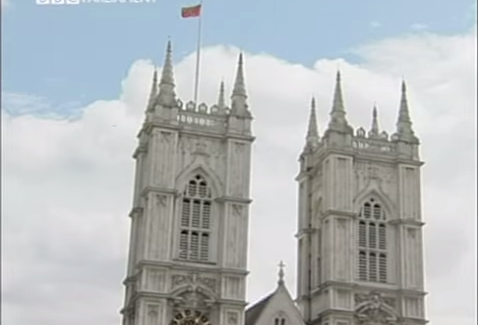 |
| Westminster Abbey Establishing Shot |
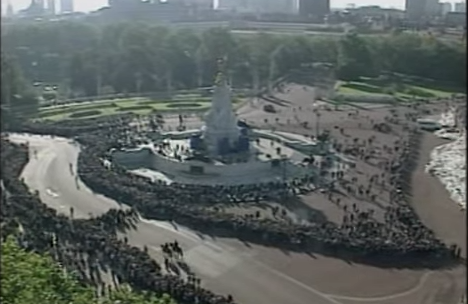 |
| Long Shot of Attended people. |
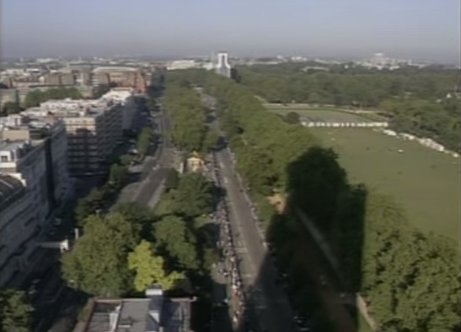 |
| The crowd waiting to see the Coffin being carried down the road. |
Here at 7:46 we see another shot of the people waiting on the side of the road to see the coffin. The use of Multi-Camera has helped a lot as it has captured the most important moments of the funeral from start till end which will allow people to remember the day she died and how her funeral was when they saw it on TV. The use of High angles shows the scale of people that were there to pay respect to Diana. By having these High / Low angles of the people who attended the funeral it shows how tragic the people felt for the death of Princess Diana. The camera Angles itself show emotions in them as well showing the event for the viewers at home.
 |
| Close Ups to show the devastation people were in. |
At 17:30 we are shown the close ups of the people who came to the funeral to show the devastation people were in towards the death of Diana. We see the people's faces who are in shock on this tragic loss. On the picture on the right we see a boy who has his head down to pay his respect to Princess Diana. If this was done with the Single Camera we would not have been able to capture these precious moments for the viewers who were watching on TV because it wouldn't have captured the most important aspects of the funeral.
With the use of Multi-Camera we are able to get a full view of the funeral while sitting at home without missing any aspects of them as each camera switches to show the movement of the coffin down London itself. Throughout the journey itself we are able to see the reactions of the residents of the UK and capture the devastated faces in detail to express how the day was very melancholic. With Multi-Camera use it has enabled us to be there without attending the actual event. The viewers are shown the whole event in angles the people who attended couldn't see in where there was establishing shots of Buckingham Palace, Westminster Abbey ect. This meant that the Multi-Camera had shown us the utmost full coverage of the event itself without missing any important factors. The Multi-Camera setup have near fixed positions which allow them to pan right/left, Zoom in and out to view the event in different viewing angles. Also the use of Multi-Cameras has an aesthetic side to it. They expressed the event in an elegant way where the shot pace was slow to express the sadness and the shots were beautifully executed to the television and Internet viewers. As they had fixed positions for the camera it had to be very important on where they placed the cameras because they would not want to miss any part of the journey through London. Also with the slow pace it allowed the cameras to capture the event in grave detail.
Live Football Match:
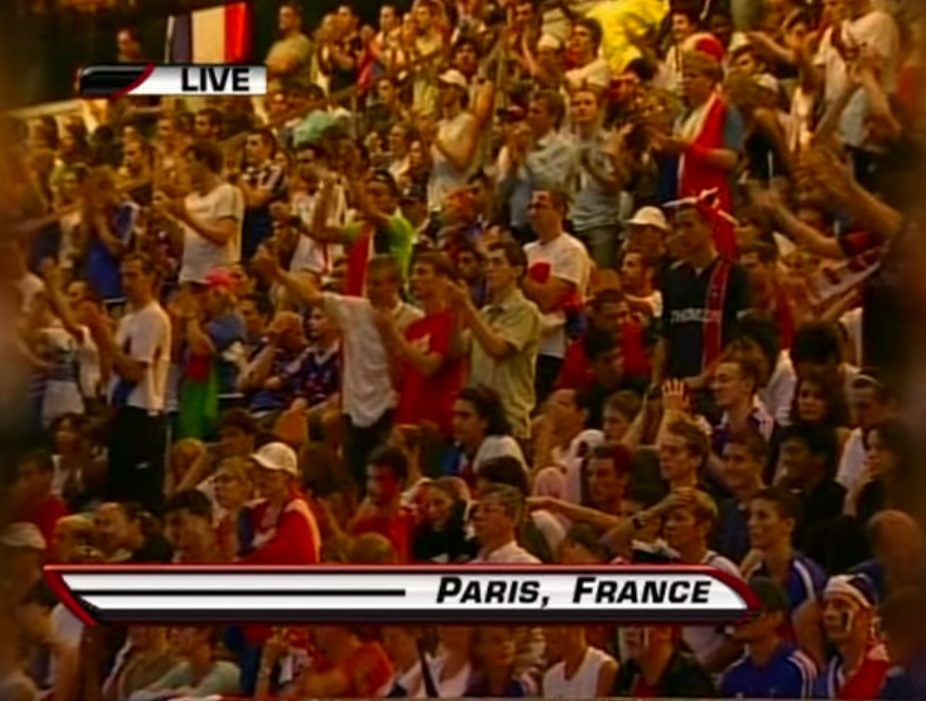 |
| Paris Supporters cheering for the referee. |
Throuhgout the football match itself it tends to be more face paced in order to the audience to enjoy the experience of viewing a football match on TV. More than 5 Shot types are used as well as therm using the cameras to pan, get closeups, Midshots ect. With that the TV Viewing experience of football will be more appealing to watch and faced paced to match the pace of the football match. At 3:33 we see the panning shot of the football players coming out of the locker rooms onto the pitch where it transitions from the locker room to the entrance of the pitch with a fade. The editing is done along with the recording so editing a 90 Minute game will be easier than ever instead of getting an editing software and rendering a 90 Minute game which would take ages.
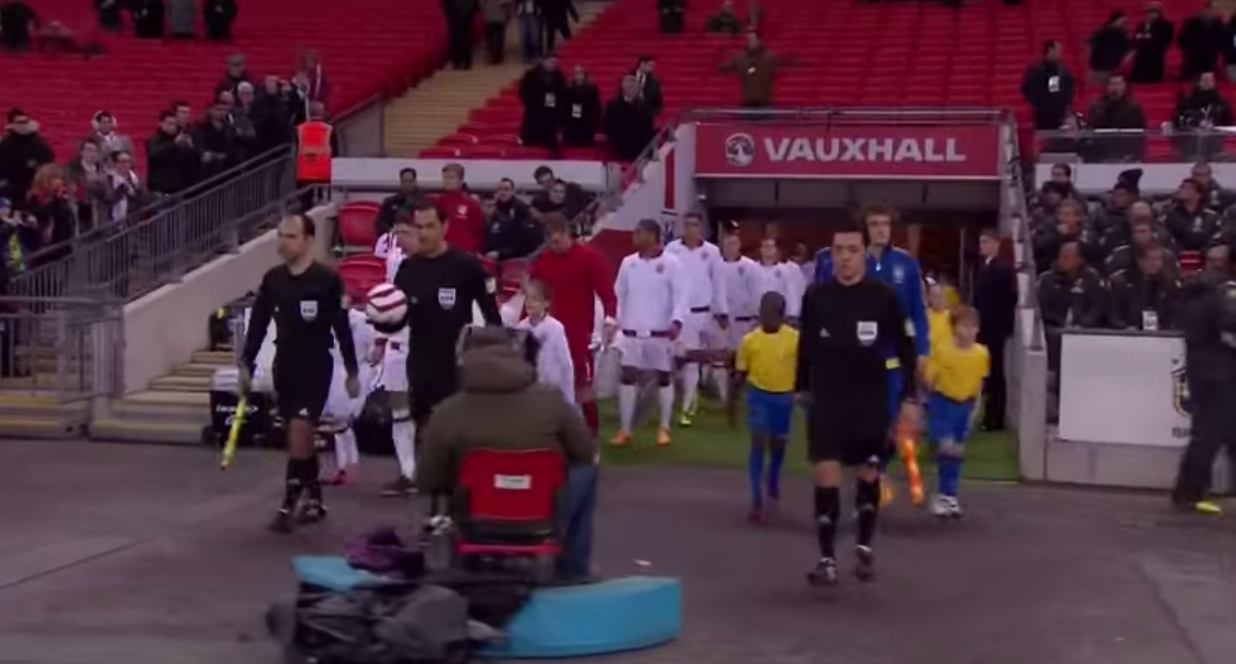 |
| 3:33 where footballers enter the PITCH. |
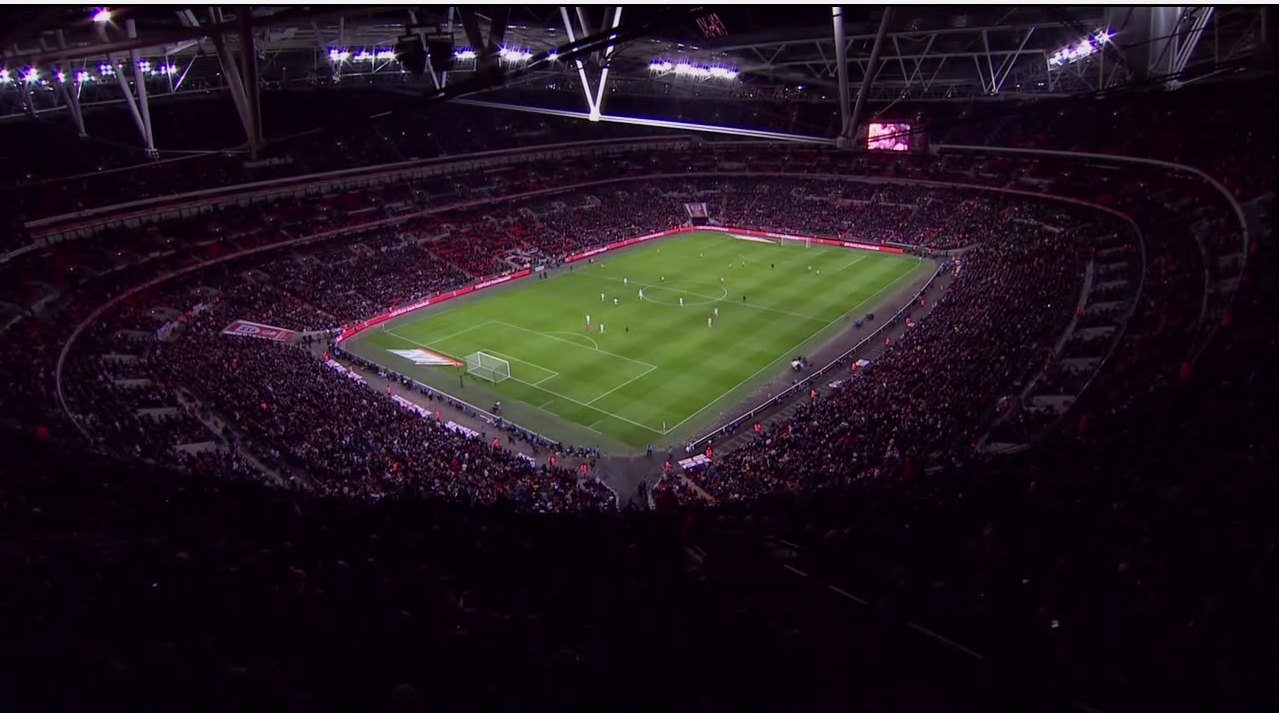 |
| Shot of the amount of people who came to watch the football match |
Around the time mark 10:45 we see a High Angle shot of the amount of people who had come in to watch the Football match and support their teams. This only could have been done with the use of the Multi Camera setup in near fixed positions because it was literally strapped to the structure of the stadium itself. This shows the astonishing amount of people who had come to watch the game to the video watchers. With Multi Cameras the TV Users get an advantage as they get to follow around the football players while they run around the pitch trying to score as if you was to be the live audience directly at the football pitch you would not be able to capture all of the viewing angles.
Game Shows:
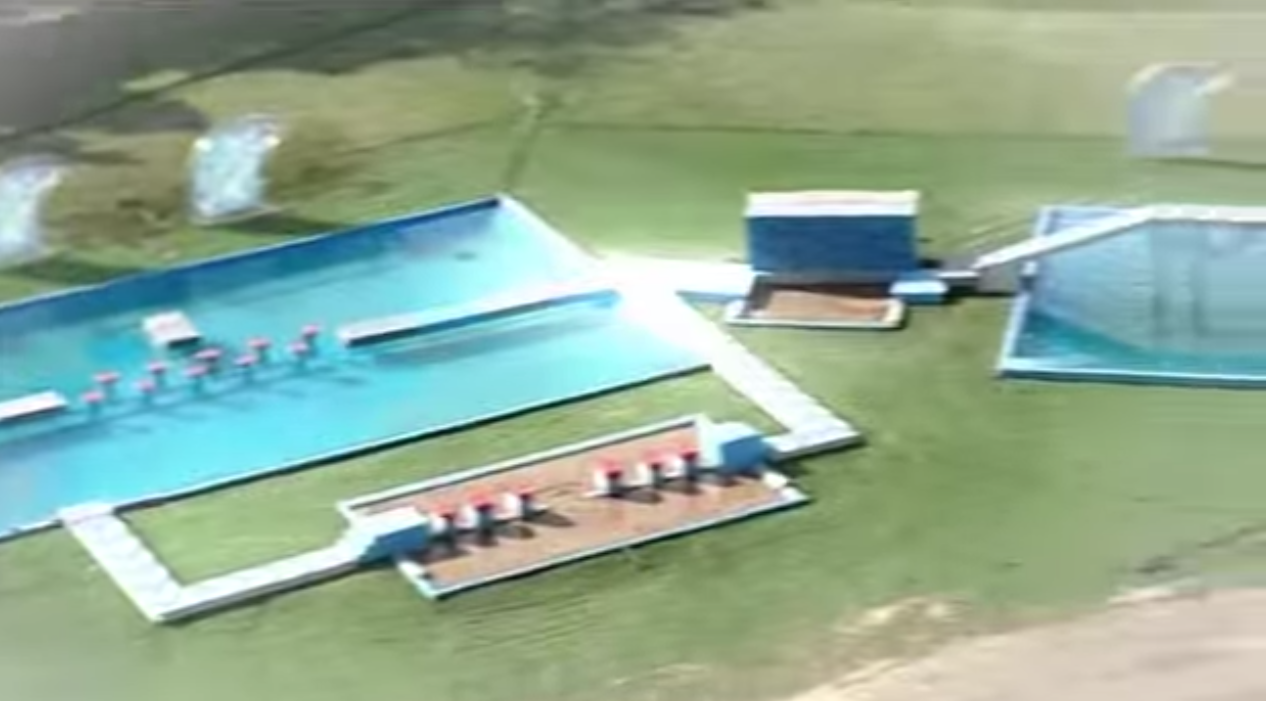 |
| Birds Eye view of the Wipeout Course |
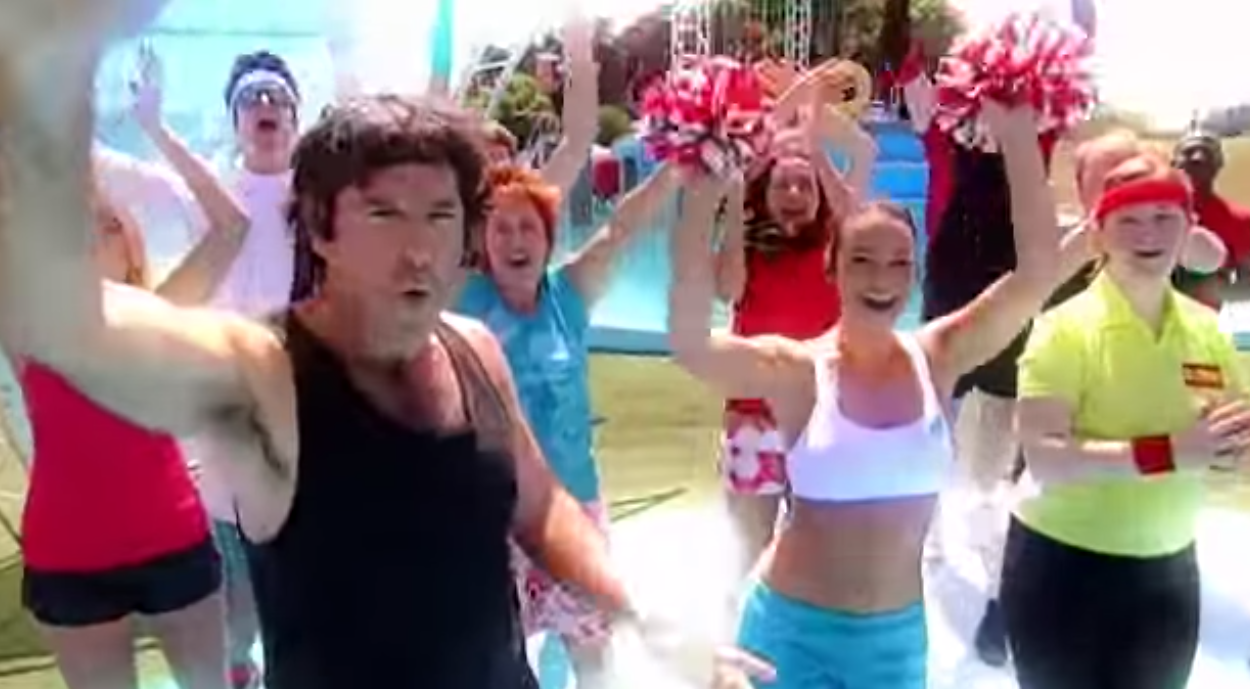 |
| View of all the Contestants |
Straight after the shot of the contestants the camera again at 0:12 pans straight up to get a full shot of all the participants dancing in joy to have the opportunity to take part in the Total Wipeout course itself in Argentina. It also shows us a glimpse of their personalities to show the audience what type of people they are whether they are serious, happy, excited. The camera's close up view allows us to show their emotions in detail for example here we see everyone very happy and they are all jumping around in joy.
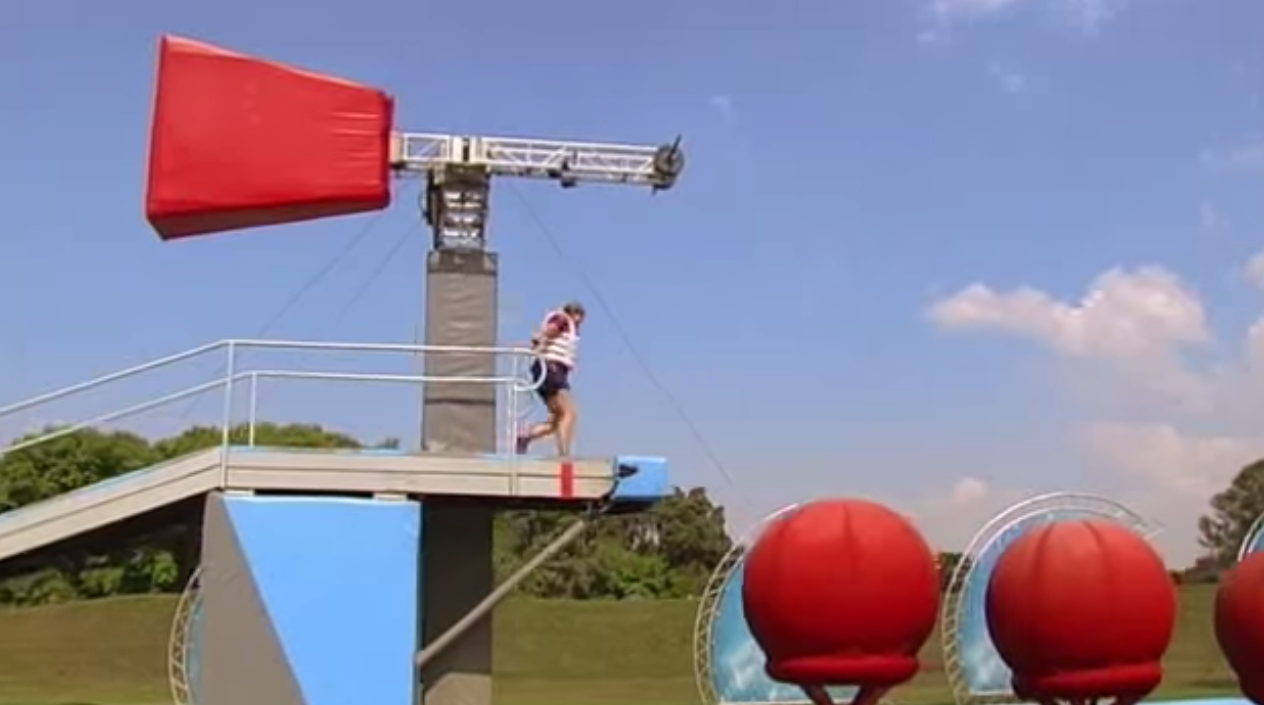 |
| Bouncy Ball Shot. |
We get a full shots of the obsticle; almost an establishing shot for the introduction of this part of the course to show the Balls and the mechanism behind her which has a few second time limit before it hits her towards the ball if she was taking long.
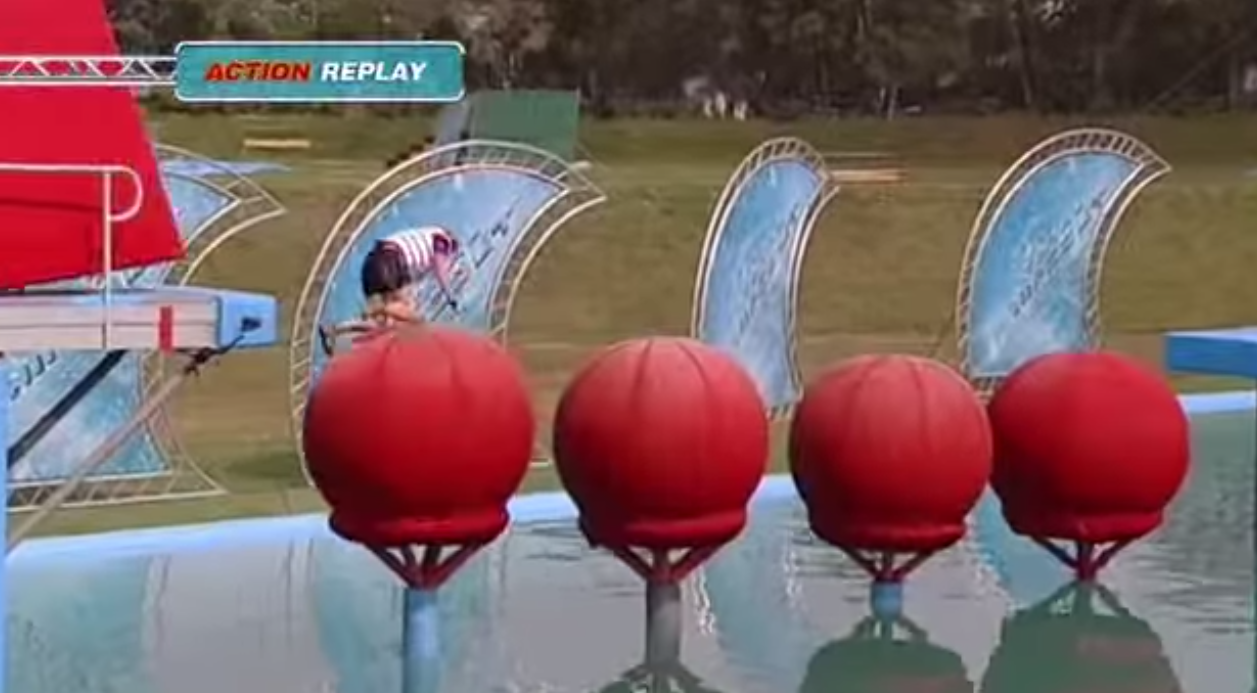 |
| Action Reply |
Here at 5:30 we see the action reply of the same obstacle. This was shown because of the Multi Camera setup they had used. Without that they would have not been able to capture such a moment of funniness for the viewers. With shots such as these the viewer is constantly engaged and is not left with bordem. The viewer is engaged all the time with the use of different angles to show her failure and to make them laugh.
Concert:
 |
| Establishing Shot of the event. |
 |
| View from the performers' point of view |
Here at 1.47 we see a point of view from the performer which shows the viewer how it would look like as the performer; It shows what the performer see through their eyes. With the use of the Multi-Camera setup we are able to see what the audience cannot see through their eyes. This is done for aesthetic reason which makes it visually appealing for the viewers of the concert. We are also able to see the amount of people that had attended the event to see the Tomorrow-Land
 perform . Again at 1:49 we see another shot of the audience via a camera from the stage. The multi-camera setup allows us to see every possible view of the concert in which the people who attended the concert cannot see. It gives a full experience to the viewer as if you was to be there because we see everything such as shots from the stage, the feeling of the people who attended the concert. The cameras allow us to see the amount of people that are dancing to the performers' performance.
perform . Again at 1:49 we see another shot of the audience via a camera from the stage. The multi-camera setup allows us to see every possible view of the concert in which the people who attended the concert cannot see. It gives a full experience to the viewer as if you was to be there because we see everything such as shots from the stage, the feeling of the people who attended the concert. The cameras allow us to see the amount of people that are dancing to the performers' performance.After the video of showing the audience the amount of people who attended, establishing shot of the whole event we are taken directly into the concert itself, meaning we are seeing high angles, low angles, audience's point of view, performers' point of view ect. This means we are directly taken into the concert without missing a piece of the whole event as the Multi-Camera setup has captured many angles of he performance itself. Also even though the Multi-Cameras are in fixed positions they are always moving to make it more visually appealing rather than keeping it a still shot and boring the viewer while watching the concert.
 |
| Near over the Shoulder shot from DJ |
 |
| Point of view from the Audience |
 |
| Shot of the whole stage where the performance is happening |
 |
| Another panning shot of the stage and showing the large amount people who have attended to watch the concert. |
 |
| Birds Eye View of the audience |
 |
| View of the audience from a high angle via Camera & Crane |
Its is vital that Talent Shows use Multi-Camera as it allows the viewers at home to get a similar experience of what you would be able to see if you was going to be there in person. Viewers at home get a better experience as they get better angles, judges facial expressions, view of the audience ect. A very good example that has all of these moments was a clip from Britain's Got Talent's Darcy Oake's performance as a magician.
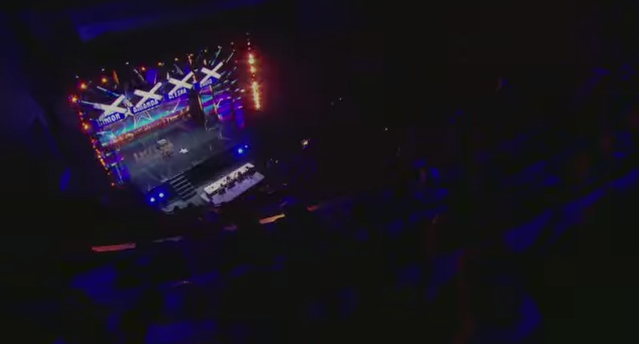 |
| Crane Shot of the audience as well as the crowd |
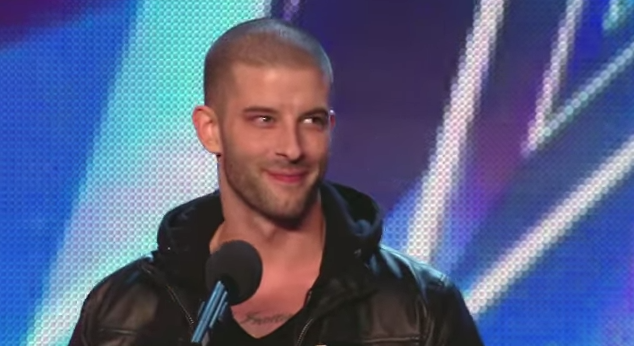 |
| Oake's expression |
At 0:09 we see a closeup of who the person is and how he look like. This is the introductory part of the performance where the performer introduces themselves and what they do for a living. With this close up shot we are able to clearly see on Television how the person looks like as if you was to sit in a crowd at the far back you will not be able to see clearly how the person looks like.
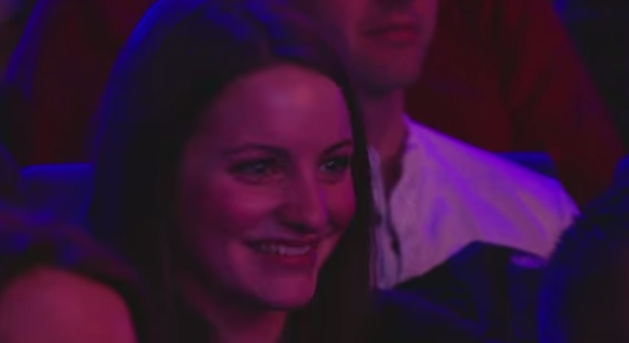 |
| Audience;s reaction to seeing him |
Straight after when we see the performer's face we are then directed back to the audience on their reaction on how they look like. Often it may be a relative but on Britain's Got Talent they are usually at the back with Ant & Dec. This close up of the audience allows the viewer at home to get a feel of how supportive the audience can be and see their facial expressions when they see the performance whether it is good or bad.
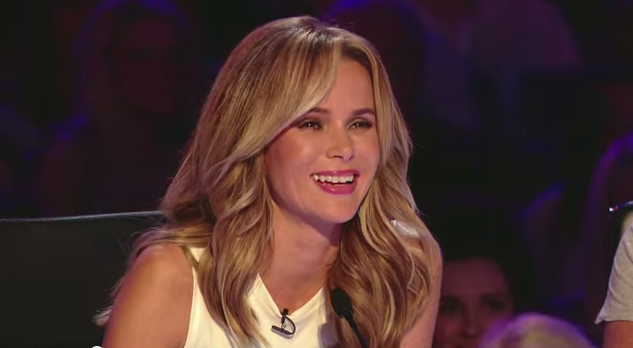
At 0:33 we see a shot of Amanda's face where she is laughing at Oake's parents insisting that he became a magician instead of his dreams of becoming a Doctor. With the Multi-Camera setup we are able to see each and every facial expression of the Judges. This can be a shocked facial expression, annoyed expression ect. The viewer at home is able to get this view because of Multi-Camera use. The audience behind will not be able to get the view of the Judge's face because they are directly behind them.
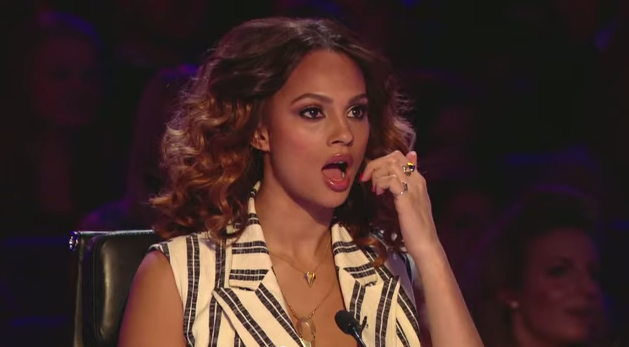
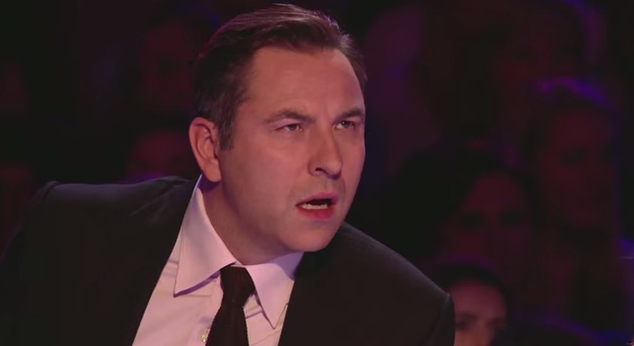
A very good example of the close up shot of the judges we get is at 1:44 where Alesha's jaw literally drops in seeing the Dove appear as an illusion. We can see clearly that she is completely blown away by the starting of the performance. This was only see-able by the viewers at home because the audience where behind her so they had no chance of seeing the initial reaction.
Here the Multi Camera not only helps the viewer see what is going on in the show but it is there for aesthetic reasons as well. The reason for this is because they want it to be visually appealing for the audience to watch instead of one boring shot which is still. It engages the viewer to keep watching the show and eventually pull them in so they do not leave. As the talent shows may have various talents the Multi-Camera setup allows all of that to be captures in angles not view able by the audience making it a better experience for the viewers.
Magazine Shows:
Magazine shows usually use Multi Cameras to capture the whole event. Straight after the Intro we are greeted by the presented via a Mid shot at 0:19. This invites the audience to watch the Magazine Show and pulls them more towards the Television. We are also seeing the two main hosts of the show. This allows the viewer to feel more comfortable knowing that the show is going to have an atmosphere where the mood is enjoyable and calm.
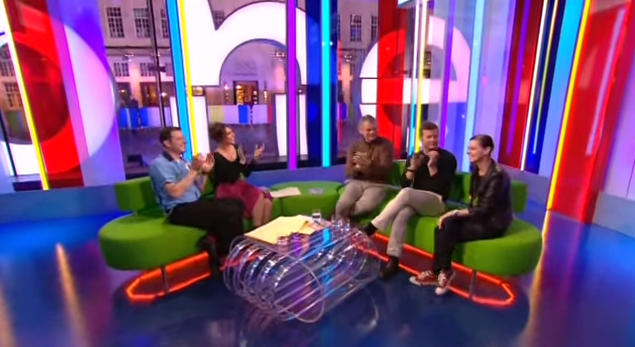
At 5:37 we are able to see the shot of the studio itself with a mini crane camera which is manually being operated by a cameraman. Thsi shows the viewer a full view of how the setup looks of the studio and who is there with the two main hosts of the show itself. The full shot gets all of the action into one frame which allows the viewer to see what is going on and who is there with the hosts. It also shows the mood of the Magazine Show as the facial expressions of the guests and the hosts are delighted to have them on the show ect.
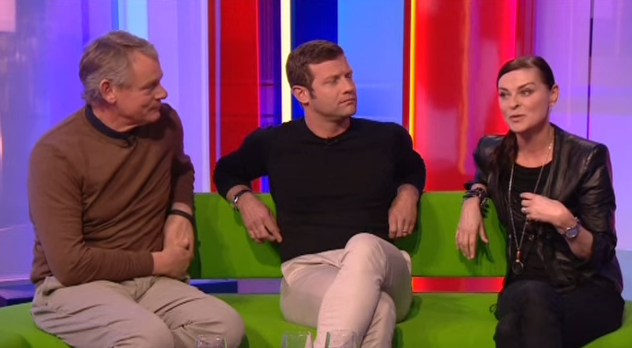
At 7:18 we are able to see a mid-shot of the guests of the show where she stalking about her movie as the role of the mother. We see that one camera is used to get facial expressions of the guests. The picture below shows the shot straight after the mid-shot of the guests where it shows a close up of Lisa Stansfield's facial expressions.
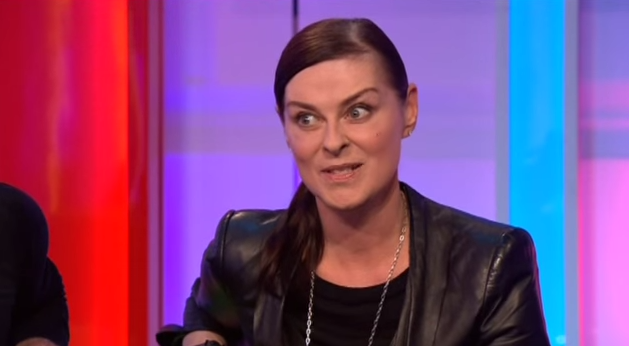
We see here the facial expressions of Lisa. This is done by the same camera that took the Midhsot view of the guests above. Here the setup has three cameras which one is pointing towards the Hosts, the other getting a full view of the conversation and the third getting the shot of the guests. These cameras are in near fixed positions and are able to move to keep the viewer more engaged instead of having shots where they are long. The shots cut at a decent pace as they do not want to bore the viewers.
Chat Shows:
A very good chat show would be the Alan Carr show. Here we have 3 cameras whoch are setup to capture the converastion between Nicki Minaj and Alan Carr himself. This has a similar setup to magazine shows but it usually has a different atmosphere to what we see on a agazine show.
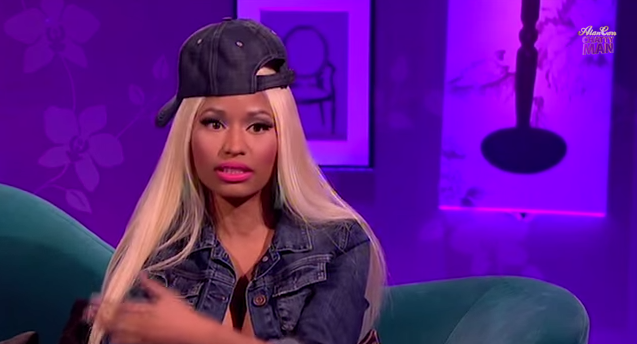
At 1:37 we see one of the cameras keeping a close up of Nicki's face to capture her reactions to seeing Alan Carr bringing the British Scones. The viewers at home are engaged straight away as it starts of with Nicki Minaj's reaction to seeing Alan Bringing the food over to the studio. This allows the audience to feel more comfortable with the atmosphere, which brings me onto my next point; Alan sets the mood of the show by bringing the food. The audience are laughing and the viewers at home are probably laughing as well due to his "Immature" side of him.
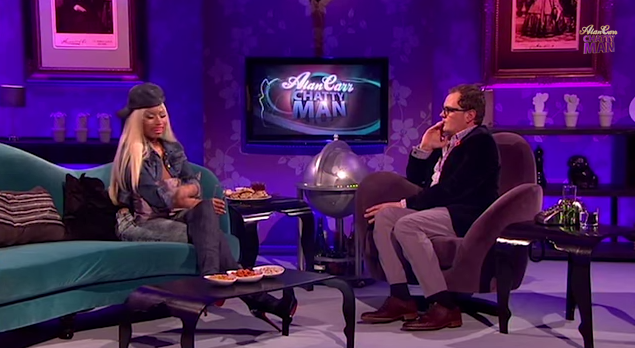
At 1:41 we see the Middle camera which captures both Nicki Minaj and Alan Carr. This shows the surroundings of them and how the tone is. The full shot of the two here is shown to the audience at home to show what the situation is like between the two; it shows the hand gestures, facial expressions in a way which the people can see in. Also with the use of Multi Cameras here we can see little details like why Alan Carr is sitting on the seat not the sofa, which all indicates he is the main host of the show ect.

Here we see the 3rd camera in action during the show at 2.18. We see Alan's reaction to Nicki Minaj "Doing what she did" during the show. We capture the moments where it has humour,. We can clearly see his facial expression of being shocked on camera and he is drinking his drink in amusement.
During magazine shows we are able to see the real side of people as in how they react how they are during shows when they are relaxed and in the mood., The aesthetic reasons for this show is that they want to keep the show at a steady pace with different angles they can switch between to keep the viewer engaged and without them leaving to watch another show.
Subscribe to:
Posts (Atom)















